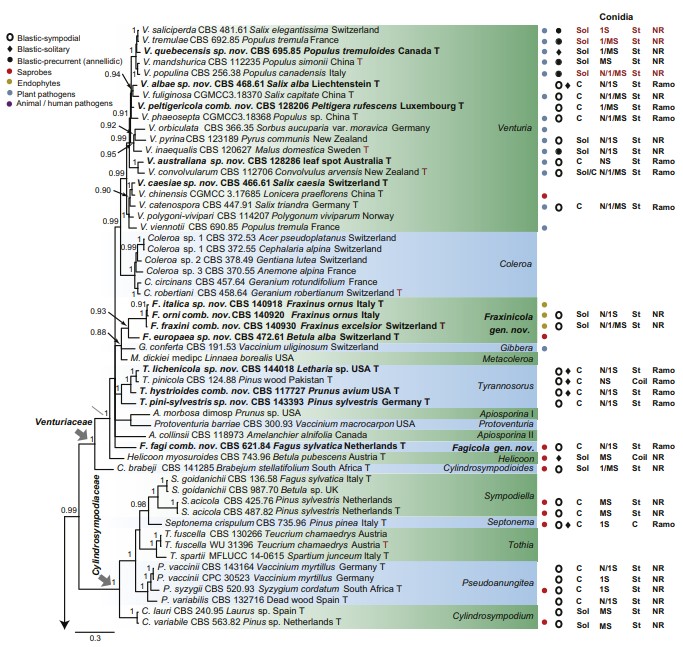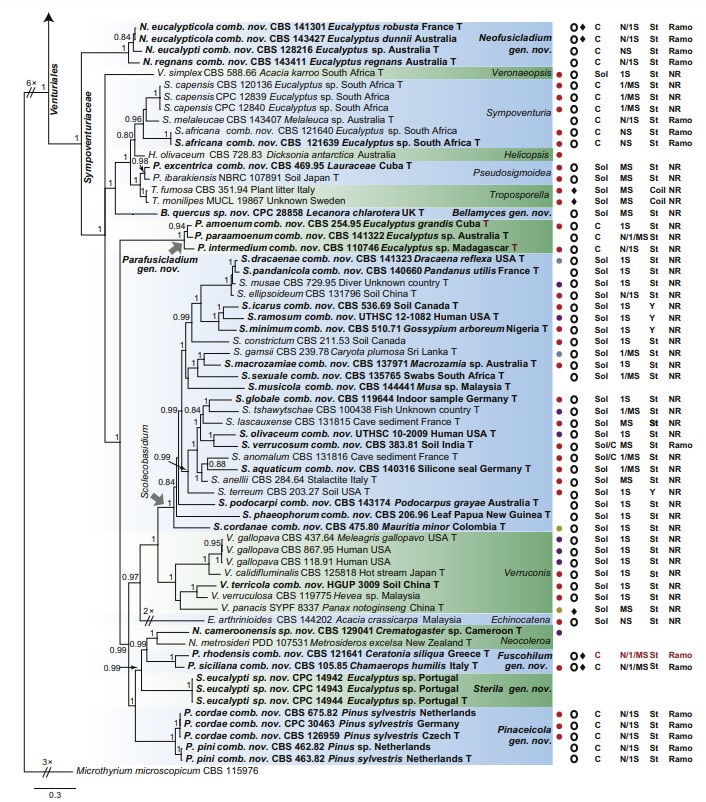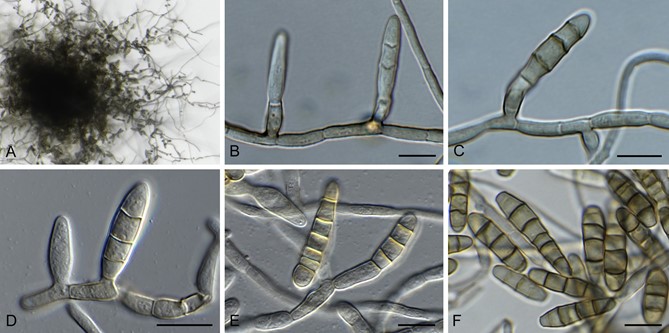Bellamyces quercus Crous, Coppins & U. Braun, sp. nov.
MycoBank number: MB 831520; Index Fungorum number: IF 831520; Facesoffungi number: FoF 12035; Fig. 3.
Etymology: The epithet refers to Quercus, the host genus on which apothecial discs of Lecanora chlarotera were collected.
Mycelium consisting of branched, septate, medium brown, smooth, 3– 4 μm diam hyphae. Conidiophores erect, brown, smooth, subcylindrical, straight to geniculate-sinuous, reduced to conidiogenous cells, or 0 – 1-septate, unbranched, 2– 10 × 4– 6 μm. Conidiogenous cells terminal, subcylindrical, brown, smooth, proliferating sympodially and inconspicuously 1– 2 times percurrently at apex, 2– 5× 4– 5 μm. Conidia solitary, brown, smooth, subcylindrical, straight, widest in middle to lower third, apex subobtuse, transversely 3– 8-euseptate, rarely with 1– 2 oblique septa, (13–)18 – 22(– 25) × (4–)5 – 6(– 6.5) μm; hila truncate, neither thickened, nor darkened, 3– 4 μm diam.
Culture characteristics: Colonies erumpent, with sparse aerial mycelium and smooth, lobate margin, reaching 7 mm diam after 1 wk at 25 °C. On MEA surface and reverse umber, on PDA surface umber, reverse chestnut, on OA surface bay with diffuse umber pigment.
Typus: UK, Scotland, VC 82, East Lothian, Spott, the Brunt, oak wood, S facing (former oak coppice), on apothecial discs of Lecanora chlarotera (Lecanoraceae) on Quercus (Fagaceae) trunks, 24 Aug. 2015, B.J. Coppins, Coppins no. 24965 = HPC 571 (holotype CBS H-23838, culture ex-type CBS 146217 = CPC 28858; isotype HAL 2918 F).
Notes: The conidia of Bellamyces are solitary, and transversely multiseptate, rarely oblique. Phylogenetically, it is not related to any other species known from sequence data (Fig. 1).

Fig 1. Consensus phylogram (50 % majority rule) of 691 952 trees resulting from a Bayesian analysis of the combined alignment of ITS, LSU, tef1, tub2 and rpb2 sequences of Venturiales. Bayesian posterior probabilities (PP) > 0.80 are shown at the nodes and the scale bar represents the expected changes per site. Some branches were shortened to facilitate layout. The tree was rooted with Microthyrium microscopicum (CBS 115976). Culture collection numbers, substrates and countries are indicated behind the species names. Those highlighted in bold are new taxa or new combinations proposed in this study, and type strains are marked with “T” (ex-type in black, ex-epitype in red). Relevant morphological characteristics plotted are abbreviated as follows: Sol – conidia solitary, C – conidia in chains, NS – aseptate conidia, 1S – 1-septate conidia, MS – multi- septate conidia (septa ≥ 2), St – straight or slightly curved conidia, Coil – coiled conidia, Y – Y-shaped conidia; Ramo – ramoconidia present, NR – ramoconidia not observed;? – asexual morphology not available (either from references or from sporulation induced in this study); and morphological characters plotted in red means strains failed to sporulate in this study and plotted values are taken from the original description, observation of this study or related references. Other characteristics are explained in the legend.

Fig 1. (Continued).

Fig. 3. Bellamyces quercus (culture ex-type CPC 28858) asexual morph. A. Colony on OA. B–E. Conidiogenous cells producing conidia. F. Multi-septate conidia. Scale bars: B–F = 10 μm.
